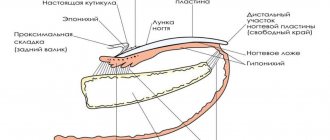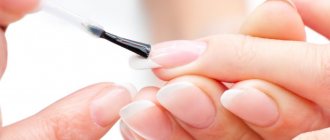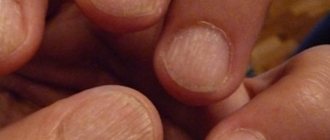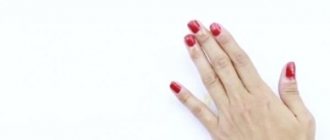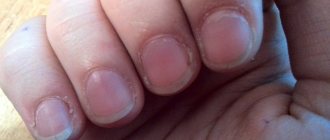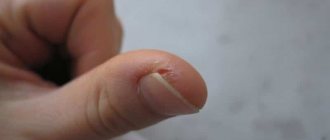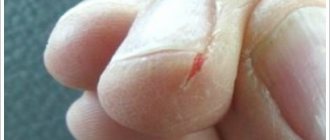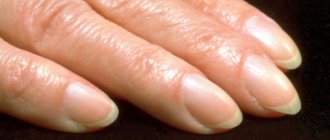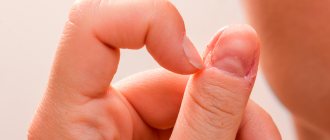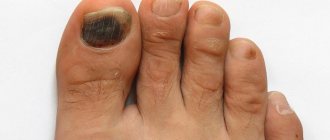Indications for nail removal.
The doctor may decide on such a procedure in the following conditions: 1. A serious stage of fungus damage to the nail plate.
Nail affected by fungus, before removal Partially removed nail affected by fungus
Some types of these microorganisms cannot be treated with medication - various creams and medications do not lead to their complete destruction. Severe deformation of the nail plate occurs, its shade changes greatly. After removing the diseased nail, a new one usually appears, without fungal infection. 2. Injury to the nail plate can also cause surgical intervention.
In case of severe damage, the nail may chip, change its color, develop inflammation and suppuration. To avoid infection and serious consequences, the best solution is to remove the nail plate. 3. The nail is completely or partially removed due to ingrown nails.
In such situations, the patient walks with difficulty due to the appearance of severe pain. In the advanced stage, the tissue around the ingrown nail plate becomes inflamed and swollen. A problem such as an ingrown toenail can cause the development of a fungal infection. For this reason, in the vast majority of cases, the nail is removed.
Indications for removing the nail plate
Nail removal is performed in cases where conservative measures do not bring the desired effect. The decision on surgical intervention is made only by a specialist, guided by the results of the examination and treatment performed.
A number of fungal diseases are practically not amenable to conservative treatment. As a result, the nail becomes deformed and begins to collapse. In this case, the surgeon at our clinic will remove the nail plate, thoroughly clean the nail bed and prescribe an antifungal agent to completely suppress the infection.
In addition to fungal infection, removal of the nail plate in whole or in part is carried out in case of ingrown nails, accompanied by an inflammatory process and suppuration.
In some cases, an injury to the nail in everyday life may be an indication for removing the nail plate. If the nail is severely damaged or split, blood accumulates under the nail plate, which can fester. A radical method of treatment in this case would be to remove the nail in a surgical hospital.
What symptoms do you see a surgeon for:
- Presence of hernial protrusion
- Daggering pains in the abdomen
- Bloating
- Pain in the right hypochondrium
- Bitterness in the mouth
- Nausea
- Presence of neoplasms on the skin
- Swelling and redness of the skin
- Bone fractures and bruises
- Wounds of any location
- Vomit
- Enlarged and painful lymph nodes
Ingrown toenail, indications for removal
An ingrown nail on the second day after removal. A completely healed nail after removal.
It is not uncommon for the nail plate to grow into the surrounding tissue. The nail can grow in on one or both sides at once.
The most common site of ingrowth is the nail plate of the big toe.
| Signs of an ingrown toenail | Causes |
| • continuous sensation of pain in a finger with an ingrown nail; • swelling and redness at the site of ingrowth; • discharge of pus from under the nail. | • improper cutting of nails; • wearing shoes that are too tight; • heredity; • altered foot shape (flat feet, valgus deviation); • finger injuries; • fungal infection. |
Ingrown nail plate is a serious problem that sometimes poses a danger to the patient’s health. Some people try to get rid of it on their own: cut off the nail or treat the inflammation.
But the main cause of ingrown nails is the changed direction of nail growth, so simple cutting will not help. Independent treatment without results can lead to an advanced stage and complications , the most dangerous of which is inflammation of the soft tissues of a purulent nature . The consequences are gangrene and amputation of the finger. Therefore, the first symptoms of an ingrown nail plate should be a reason to consult a doctor. The following contraindications exist for surgery for an ingrown nail plate: • if you are simultaneously treated with certain medications that affect blood clotting (antiplatelet agents); • diseases associated with disruption of the endocrine system (severe diabetes mellitus); • vascular diseases and vascular stenosis of the lower extremities.
How to remove a toenail
When the doctor says “resection of the nail plate is necessary,” most people get goosebumps, because they immediately imagine a clinic office, surgical instruments, a wound, blood, pain. You shouldn’t delve into such thoughts, because in reality, enduring pain every day with every step is much more painful than having your big toenail removed for medical reasons.
You also need to know that today other methods of treating onychocryptosis are used - for example, laser removal of a toenail or getting rid of the disease using radio waves. A person who suffers from this disease simply needs to compare the different ways in which the thumb can be cured. The patient can make a balanced choice of treatment method by comparing which treatment method is most suitable for him:
- by type of impact;
- healing rate after intervention;
- price for performing the manipulation;
- the amount of necessary medications.
- Meat in pots in the oven: recipes with photos
- How to unlock an iPhone if you forgot your password
- Pneumatosis intestinalis - symptoms and signs. Treatment of pneumatosis intestinalis with drugs and folk remedies
Laser
This is a gentler method of treating onychocryptosis than conventional surgery. Laser removal of an ingrown toenail involves evaporating the overgrown edge by applying high temperature. This procedure is performed on an outpatient basis under local anesthesia and takes up to 20 minutes. After completion, the patient has virtually no painful sensations, because the laser does not affect healthy tissue. This almost halves the patient’s recovery period after the intervention compared to surgery, and also prevents the risk of improper growth of the nail plate in the future.
Operation
This method has been used for a very long time; photographs of this procedure and its results are very common. How to surgically remove an ingrown toenail:
- Under local anesthesia, the surgeon makes an incision in the skin of the big toe over the affected area.
- The ingrown segment is eliminated with a scalpel and part of the matrix of the horny plate is excised to prevent the possibility of ingrowth in the future.
- The wound is treated with antibiotics.
- The patient needs to bandage the next two weeks, apply prescribed ointments to the finger and follow a gentle regime for the leg. Recovery is expected in a month.
Patch
The plaster has become the least traumatic and at the same time affordable. The remedy is often used in home treatment to get rid of fungus-affected toenails of the big toe. Keratolytic patch is a representative of a special group of products; it can be purchased inexpensively in an online store from a catalog. How to remove a toenail using it:
- First, be sure to cover the healthy skin of the big toe with a regular plaster - this will protect it from the effects of keratolite.
- Next, the plaster mass is applied in a thick layer and sealed, leaving it to act for 2-3 days.
- After removing the patch, parts of the affected nail plate are removed with scissors or forceps and the bed is treated with antifungal agents.
- Applications are repeated until complete healing.
Which specialists should I contact?
Podologist
In situations where an ingrown nail plate or fungal infection or injury occurs, you should not self-medicate, you should immediately consult a doctor.
A surgeon or dermatologist will help with such a problem as an ingrown toenail. In some medical institutions, patients with this diagnosis are seen by a podiatrist. The specialist will conduct an examination and prescribe additional tests to prepare for surgery. Usually limited to a general analysis of urine and blood. In case of an ingrown toenail a culture of pus is performed in case of infection of the nail plate. This is necessary to identify pathogenic microorganisms and determine their sensitivity to antibiotics. In case of severe suppuration, an X-ray examination of the foot is additionally performed to determine whether the bone is affected. In case of fungal infection of the nail, it is better to consult a mycologist or dermatologist . Specialists will assess the severity of the case and, if necessary, provide a referral for surgery to remove the nail plate. If you have a nail injury, you should consult a surgeon or traumatologist.
Methods for removing the nail plate
In cases where it is not possible to cure the nail plate, they resort to its removal. There are several main ways to remove a nail:
- Surgical intervention. Required in extreme cases when other methods are less effective. The operation to remove an ingrown or injured nail is quite painful, but with the help of modern medications, specialists manage to reduce discomfort to a minimum.
- Medication methods.
- Applying a nail removal patch.
- Hardware manicure.
- Radio wave method.
- Laser therapy. A painless and fairly quick way to remove a nail plate.
- Chemical method. The nail is removed under the influence of chemicals that destroy its structure.
Surgical nail removal
Surgical removal of part of an ingrown toenail has long ceased to be the only way to solve the problem. Experts recommend resorting to this option when the condition of the nail is neglected. The operation is performed under local anesthesia, but the patient may feel pain for some time after the nail is removed.
The nail is separated from the nail bed using a scalpel, after which the wound is carefully treated with an antibiotic to protect the nail from infectious and fungal bacteria. The method is contraindicated in patients with a low rate of regeneration of damaged tissue, as well as poor blood clotting.
Hardware pedicure
Hardware pedicure is performed by a medical pedicurist. For this purpose, special equipment is used, and before the procedure begins, the finger is placed in a special solution to soften the tissue.
Hardware pedicure is used to remove part of an ingrown or injured nail. Special staples are used to straighten the nail plate. The procedure is quite painful, but under the guidance of an experienced specialist, discomfort is minimized.
Laser therapy
Laser therapy is a method that is actively used at present and allows one to avoid surgical intervention. Pain is eliminated in just one session, as laser therapy is quite effective. To prevent the patient from feeling discomfort and pain, the procedure is performed under local anesthetic.
Laser nail therapy takes about twenty minutes. The main advantages of this procedure include:
- No pain.
- The process is quite fast and efficient.
- Absence of any relapses and bleeding.
- Quick rehabilitation of the nail plate.
- Aesthetics.
With laser therapy, only the damaged area of the nail is removed, the healthy part remains untouched. However, the procedure is contraindicated in patients with poor blood clotting, as well as in the presence of diabetes mellitus and other blood and vascular diseases.
Chemical method
It consists of using various chemicals that soften the nail, after which it is easily and painlessly removed. The procedure consists of the following steps:
- Cleaning the nail plate.
- Gluing a special tape around the nail to protect the delicate skin from possible damage.
- Applying a chemical solution to remove nail fungus.
- The ointment is secured on top with a bandage.
It takes 3-4 days to wear this bandage, after which the nail will be removed easily and painlessly.
Radio wave
The procedure involves minimal pain and is also performed under local anesthesia. The affected areas of the plate are treated using radio waves, then covered with a sterile bandage to avoid complications after nail removal.
The discomfort disappears the next day, and the patient can return to normal life.
Removal methods
The following methods can be used to remove the nail plate:
| radio wave; | surgical; |
| laser; | chemical. |
The best method of all is considered to be radio wave. It is distinguished by its painlessness and low probability of recurrence of the disease, and rapid healing.
Radio wave nail removal
Laser removal
The procedure for ingrown toenails is carried out in three stages: 1. local anesthesia; 2.part of the nail plate is removed to the desired width; 3.The inflamed side of the finger is removed and cleaned with a laser. This method also has many advantages. These include: + optional complete removal of the nail plate - removal of only the ingrown part; + avoiding injury to surrounding tissues; + stopping the development of inflammation by cleaning tissues from infections; + short duration of the procedure; + low probability of relapse; + painlessness. The only disadvantage of this method is the long rehabilitation period. Contraindications to this method of removing the nail plate are the presence of diabetes mellitus and blood clotting disorders.
chemical nail removal
Chemical nail removal
This method is not surgical, so the removal procedure is absolutely painless.
With this method, only the part of the nail that is affected by the fungus is removed. Stages of performing chemical nail removal:
| 1. The doctor seals the tissue around the affected nail with an adhesive plaster. 2. After preliminary scraping off the shiny layer, a special ointment is applied to the surface of the nail plate and sealed with an adhesive plaster. The bandage is not removed for a week, and the foot is not allowed to get wet. 3. After this time, the doctor will remove the bandage and remove the softened nail by lifting or cutting out the affected part. |
The healing process takes place within 14 days after the procedure. A healthy nail grows completely within six months, in rare cases – a year. This method of removing the nail plate is mainly used when it is infected with fungus. Much less often, chemical removal of the nail plate is used for abnormal growth. After removing the damaged part of the nail, the doctor may suggest additional treatment of the infected area - applying a local remedy or taking special medications. The chemical method of removing a nail is associated with certain risks: 1. Possible infection of the wound after removal of the nail plate. To prevent this, it is necessary to keep the treated area dry and clean, and regularly apply antibiotic ointment. 2. If the fungus is not completely eliminated, microorganisms can be transferred to the growing healthy nail. But if the chemical nail removal procedure is carried out correctly, these risks will not be worth it.
Surgical intervention
Surgical removal of the nail plate can be: – complete; – partial.
Partial removal is also called resection .
Resection - partial removal of the nail
Complete is carried out in cases where purulent inflammation of the tissues surrounding the nail occurs. The advantage of this method is the prevention of bone suppuration.
But the surgical method also has many disadvantages:
- painful process
- long rehabilitation,
- the possibility of relapse,
- growth of a deformed nail plate.
The treated area is healed and a bandage is applied until a healthy nail grows back. Sometimes this process takes up to six months.
If completely removed, the doctor may damage the growth zone of the nail plate. This is fraught with relapse or cessation of nail growth.
Today, surgery to remove the nail is quite rare.
Radio wave method for removing ingrown nails: algorithm
The first advantage of this method is that it is a completely painless procedure. It is worth noting that relapse after the procedure is unlikely (after surgery, relapse is observed in 40 percent of cases).
So, the whole procedure takes approximately five minutes. Its duration directly depends on how advanced the situation is. After resection, the patient is sent home; there is no need to place him in a hospital setting.
The work algorithm is carried out in the following order:
- treatment of the affected area with antibacterial agents;
- application of local anesthetic;
- a procedure is performed to remove an ingrown toenail;
- radio waves also treat the growth zone and nail matrix;
- Excessive growth of soft tissue is removed;
- an antiseptic bandage is applied.
There are a number of contraindications to the procedure, namely the presence of a built-in pacemaker, diabetes mellitus during decompensation, the presence of chronic hepatitis; infectious diseases in an acute form, problems with the functioning of the cardiovascular system during an exacerbation. It is worth noting that patients who suffer from panic attacks are first advised by the doctor to take sedatives.
Removing a nail using "Nogtivit"
Today, the drugs “Nogtivit” and “Nogtimitsin” for painless removal of the affected part of the nail plate.
"Nogtivit" is a drug that has a safe composition that does not harm the nails. Both products contain stearic acid and tea tree oil, which help disinfect and disinfect the nail surface and accelerate the growth of new nails.
The urea included in the products allows you to soften the nail and remove keratinized particles from it. Wax has an antimicrobial function and is necessary to fight infections: fungi and bacteria.
Removing nails using these drugs is performed as follows:
1. First, the feet are steamed in hot water with the addition of soap and soda. This is necessary in order to soften dead cells. Nails are thoroughly dried. 2. The skin around the nail is sealed with adhesive tape. 3. Apply cream thickly to the affected nail plate without rubbing. If it gets on the skin, wash it off with water. 4. An adhesive plaster is applied to the nail. It is left in this form for 4 days. 5. The patch is removed, the nail is steamed again and then the softened layers are removed with a file or manicure scissors. 6. These steps are repeated until the affected area of the nail is completely removed.
One jar of product is enough to remove 3 or 4 nails.
The only contraindication for the use of Nogtivit is individual intolerance to certain components of the product.
Methods for removing nails at home
A fingernail or toenail affected by a fungal infection must be removed. The operation to remove the nail should be carried out in a clinic, using sterile instruments or specialized devices.
There are home methods, but they are all risky due to the high risk of re-infection. How to remove a nail affected by fungus - a detailed description of home techniques is presented below.
Soda baths
Baking soda creates an alkaline environment in which mushrooms cannot survive. Additionally, soda baths soften the affected tissue, facilitating the removal process. How to use baking soda to achieve your goal?
- Steam 1.5 tablespoons of soda with a liter of boiling water.
- Dilute the solution with 2 liters of cold water.
- Use the bath mixture for 10-15 minutes.
- After softening, use manicure tools to remove the softened top layer of the nail plate.
The procedure should be repeated every 3-4 days until the final result is obtained. After each session, all instruments used must be sterilized.
Tar compress
Birch tar accelerates tissue regeneration, has antifungal properties and relieves inflammation. A natural remedy is also used to remove nail plates destroyed by fungus.
Step-by-step instructions for use:
- Steam your fingers in a warm bath with tea tree oil.
- Wipe the surface dry.
- Apply tar heated to room temperature to the affected nail and hole.
- Cover with cling film.
The procedure is performed before bedtime. During the night, the active components of the tar will eliminate inflammation and soften the plate. The remaining tar should be washed off, and then the peeled part of the plate should be removed with a file.
Vinegar
Vinegar creates an acidic environment, thereby regulating the acid-base balance in the area of application. Acetic acid, even in low concentrations, destroys fungal infections and softens the damaged area.
Directions for use:
- Concentrated vinegar essence is applied with a cotton swab to the affected area every 2-3 hours. Within a week it will soften and can be easily removed using manicure tools.
- The medicine is prepared from 100 ml of table vinegar and 1 raw egg. The mixture should be rubbed into the nail hole and plate every 2-3 hours for 5-7 days. After the course of treatment, the loose area can be easily removed using a file with large abrasive particles.
“It is unsafe to use acid after a bruise, in the presence of abrasions and cracks in the skin. It is not recommended to use vinegar for warm baths. Acetic acid evaporates quickly, and inhaling its vapors is harmful.”
Spurge
To treat the fungus and remove the affected dead layer, use a strong infusion or decoction of milkweed. How to remove fingernail or toenail using this plant.
- Boil 100 grams of dry plant material in 0.5 liters of boiling water (euphorbia is sold at the pharmacy).
- Let the broth brew for 2 hours.
- Strain and dilute with warm water for a bath.
After a half-hour bath, it is necessary to cut off the loose layer and disinfect the treated area. This method is popular and almost every thematic forum contains information about it. People's reviews are mixed, so you shouldn't count on the maximum effect.
Diagnosis of infections using a removed nail
Nail analysis
fungal infections of the nails - various types of onychomycosis - are diagnosed using a removed nail plate . Other pathogens can also be identified, such as Pseudomonas aeruginosa (Onychia pseudomonas ), bacteria ( paronychia ).
When a fungal infection occurs, white or yellow spots appear on the nail plates. Thickening and separation of the nails from the nail bed also occurs.
After removing the nail plate, a large fragment of it is sent to the laboratory for analysis and refutation or confirmation of the presence of a fungal or bacterial infection.
Matrixectomy of the nail plate
Matrixectomy is a way to remove the growth zone of the nail plate when it is affected by a fungus. The nail matrix is the germinal epithelium that forms the nail, that is, the cells of which it consists are formed in it.
Matrixectomy is also performed for ingrown nail plates. But this method of nail removal is allowed only after all methods have failed (including partial or complete removal).
The most common procedure is a partial matrixectomy. This is done in order to try to preserve the central section of the nail. This is also necessary to maintain the normal structure of the nail and its functioning.
completely removed nail
A complete matrixectomy is performed for acute or chronic dystrophy of the nail plates, in the absence of treatment results by all other methods.
Treatment after nail removal
Treatment after the nail plate removal procedure consists of regular daily treatment of the affected part with antibiotic ointments and bandaging. It is possible to take antibiotics orally .
In order to avoid pain, special medications are prescribed - Acetaminophen or Ibuprofen. The main requirement during the rehabilitation period is to ensure rest of the affected finger in the first 24 hours after surgery. After the first day, the patient can begin to walk, but minimal loads are allowed on the affected limb. Before any actions related to caring for the affected limb, be sure to wash your hands. This is necessary to prevent bacteria from entering the wound. The dressing should always be clean and dry. It is also better to wear cotton socks and loose shoes. This is necessary for free blood circulation in the limb and reducing pressure on the fingers. Physical activity at first can cause swelling of the affected finger. The surgeon may prohibit vigorous activity for the entire rehabilitation period.
Folk remedies for nail removal
If there are contraindications to surgical removal of the nail plate, folk remedies can help. The principle of operation of these methods is to soften the stratum corneum of the nail plates, disinfection of fungal pathogens, and eliminate the affected parts of the nail using nail scissors at home. – One of the effective folk remedies is a mixture of sunflower oil, dimethyl phthalate and 1 chicken egg. The first ingredient will need 1 tsp. All components are mixed and applied to the affected area, polyethylene is applied on top, secured with a bandage and left in this form for 9 hours. This procedure is usually performed overnight. To make it painless, the steps are repeated for 4 days.
Birch tar
– Another equally effective remedy is the use of birch tar, obtained after burning birch bark or purchased at a regular pharmacy. Tar is applied in the same way as in the first recipe. The only difference is that in the morning the feet are thoroughly washed to remove tar. – The use of a hot bath with soap and soda also contributes to the deterioration of the nail. The procedure is performed for 20 minutes, after which the stratum corneum of the nail plate is carefully removed with nail scissors. One procedure is not enough to remove the entire nail. The bath will need to be repeated over more than one day - sometimes weeks. All methods of removing the nail plate using folk remedies are recommended to be agreed with your doctor.
Benefits of treating onychocryptosis with laser
Compared to other destructive methods, laser removal has the following features:
- Minimal risk of bleeding. The laser has coagulating properties - that is, it seals the vessels that nourish the tissue.
- Painless procedure. The manipulation is performed using local anesthesia.
- Minimal trauma. Thanks to the targeted laser action, surrounding tissues are not damaged.
- Short rehabilitation period. Recovery lasts about two weeks.
- Minimal risk of developing postoperative complications. The laser beam has a bactericidal effect, removing all pathogenic microorganisms, which eliminates the possibility of wound infection.
There is no need to completely remove the nail plate. Using a laser, you can remove only the pathological area, while maintaining the aesthetic appearance of the finger.
The likelihood of recurrent onychocryptosis after laser treatment is minimal.
Preventive measures to restore the nail plate
To prevent complications, you should adhere to the following rules:
- ensure maximum rest for the injured limb;
- try to step more on your healthy leg;
- Wash your hands thoroughly before any procedures;
- Wear clean socks and comfortable shoes every day;
- Be sure to follow your doctor’s instructions and take prescribed medications.
If after the operation there is severe pain or redness and swelling of the periungual tissues, purulent discharge, this is a serious reason to consult a doctor.
Thus, strict adherence to hygiene and preventing dirt and water from entering the wound area will ensure successful healing of the finger within 1-1.5 months.
In non-advanced stages of ingrown nails, instead of removal, it is possible to install a plate or bracket on the nail.
